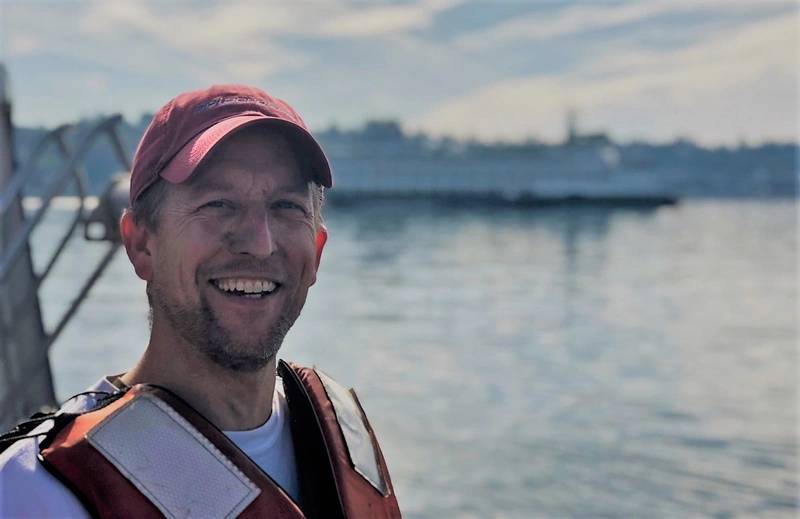Mitigating Underwater Noise
Noise Control Engineering, LLC (NCE) recently completed an underwater radiated noise study for Washington State Ferries (WSF), a study which entailed measurement of nine vessels representing all seven operating classes of WSF vessels, quantifying noise, potential impacts to orcas and other marine life, and methods of reducing noise.
“With the increasing awareness of underwater noise impacts on marine life, both globally and locally in the Northwest, WSF is interested in learning more about how their operations may impact marine life,” said Jesse Spence, President, NCE. “They are also interested in learning what aspects of their vessel designs cause underwater noise, and if they can reduce their impacts through procedural changes as well potential improvements to the design and engineering of their vessels.”

“This work provides the information that WSF needs to take the next steps towards operational and engineered mitigation measures to reduce the impact of underwater radiated noise from our vessels on marine life, particularly the critically endangered Southern Resident Killer Whale,” said Kevin Bartoy, Environmental Stewardship & Sustainability Program Manager, Washington State Ferries.
NCE used its Buoy Acoustic Measurement System (BAMS) to perform vessel noise measurements in general accordance with ANSI S12.64 while allowing the vessels to maintain their normal operating schedule. Simultaneously, vessel operational and environmental data was collected allowing for assessments of noise at varying propeller RPMs, operating powers, and speeds. This information was compiled into a database which was used to calculate ‘source levels’ and identify impacts to marine life using NMFS guidelines. The measurement data was also used to identify causes of noise ranging from propeller cavitation to specific machinery items.
Cutting ship noise
While emissions from ship exhaust has been the main target of regulators to reduce shipping’s impact on the environment, the matter of noise mitigation with a focus on its impact to wildlife has been a long-running concern, growing in stature in recent years as the overall health and well-being of the ocean and ocean issues have risen in the public conscience.
“Early in 2019 there was a meeting held at the IMO offices in London, organized by Transport Canada, to attempt to quantify what we should do regarding underwater noise limits and quantifiable approaches to noise mitigation. These meetings have all been in response to the rising recognition of our impacts to marine life, with respect to noise,” said Spence. “Looking forward, I believe there will be greater acceptance of established noise criteria as independent operators design vessels that meet these criteria and modify existing vessels to reduce underwater noise. This issue has been discussed for nearly (or possibly more than) 20 years, and the momentum is building.”
Drivers and solutions
According to Spence, there are efforts to put more regulations in place, particularly for newbuilds, as a focus on shipborne noise continues to grow. “The marine vessel operator community is generally aware of the issue, and some are concerned that if the community does not take action to reduce noise emissions on their own, then tough limits will be set for them.
One of my main takeaways from the 2019 IMO/Transport Canada meeting is the technology is available to reduce noise on commercial vessels. However, the desire and need to have reduced noise must be stated clearly in the vessel specification or it will not get implemented.”
With the wide variety of private, commercial and government vessels plying the world’s waterways, there is no single ‘silver bullet’ solution used to mitigate noise from boats and ships. “Every vessel is different, and there is no ‘one size fits all’ solution for underwater noise,” said Spence.
“However, propeller cavitation is a prominent feature of underwater noise for most commercial vessels. Machinery noise will also play an important role, particularly propulsion engines, gensets, gearboxes, and other large equipment.”
When asked define ‘top tips’ to mitigate underwater noise, Spence admitted “Really, I have one. Put a limit in your vessel specification and require the vessel to be designed to meet it. There currently are a variety of underwater noise classifications from ABS, Lloyds, DNV GL, and others. Environmental’ limits are available which are aimed at reducing underwater noise emissions without imposing onerous design limitations and the need to put damping on every panel, stiffener, dinner plate, etc. The more these limits are used the more we will learn about what it takes to meet them (with the associated confidence that they can be met), and what this all means to marine life. The limits will likely change over time, as we learn more and refine our understanding of quiet ship design and impacts to marine life. But without the first step of stating “I want lower noise,” no progress will be made.
